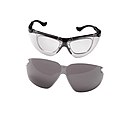
A corrective lens is a transmissive optical device that is worn on the eye to improve visual perception. The most common use is to treat refractive errors: myopia, hypermetropia, astigmatism, and presbyopia. Glasses or "spectacles" are worn on the face a short distance in front of the eye. Contact lenses are worn directly on the surface of the eye. Intraocular lenses are surgically implanted most commonly after cataract removal but can be used for purely refractive purposes.

Glasses, also known as eyeglasses and spectacles, are vision eyewear with clear or tinted lenses mounted in a frame that holds them in front of a person's eyes, typically utilizing a bridge over the nose and hinged arms, known as temples or temple pieces, that rest over the ears.
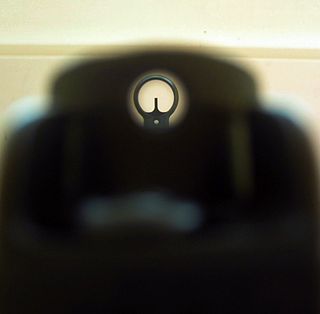
Iron sights are a system of physical alignment markers used as a sighting device to assist the accurate aiming of ranged weapons (such as a firearms, airguns, crossbows, and bows, or less commonly as a primitive finder sight for optical telescopes. Iron sights are the earliest type of sighting device, as it relies completely on the viewer's naked eye, and is distinctly different to optical sights such as telescopic sights, reflector sights, holographic sights, and laser sights, which make use of optical manipulation and/or active illumination.
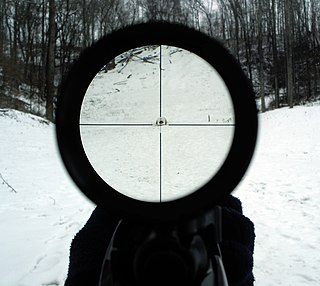
A telescopic sight, commonly called a scope informally, is an optical sighting device based on a refracting telescope. It is equipped with some form of a referencing pattern – known as a reticle – mounted in a focally appropriate position in its optical system to provide an accurate point of aim. Telescopic sights are used with all types of systems that require magnification in addition to reliable visual aiming, as opposed to non-magnifying iron sights, reflector (reflex) sights, holographic sights or laser sights, and are most commonly found on long-barrel firearms, particularly rifles, usually via a scope mount. Similar devices are also found on other platforms such as artillery, tanks and even aircraft. The optical components may be combined with optoelectronics to add night vision or smart device features.

The FN F2000 is a 5.56×45mm NATO bullpup rifle, designed by FN Herstal in Belgium. Its compact bullpup design includes a telescopic sight, a non-adjustable fixed notch and front blade secondary sight. The weapon has fully ambidextrous controls, allowed by a unique ejection system, ejecting spent cartridge casings forward and to the right side of the weapon, through a tube running above the barrel. The F2000 made its debut in March 2001 at the IDEX defence exhibition held in Abu Dhabi, in the United Arab Emirates.
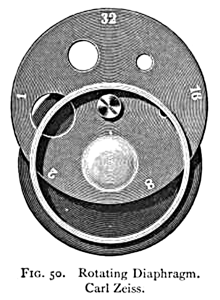
In optics, a diaphragm is a thin opaque structure with an opening (aperture) at its center. The role of the diaphragm is to stop the passage of light, except for the light passing through the aperture. Thus it is also called a stop. The diaphragm is placed in the light path of a lens or objective, and the size of the aperture regulates the amount of light that passes through the lens. The centre of the diaphragm's aperture coincides with the optical axis of the lens system.
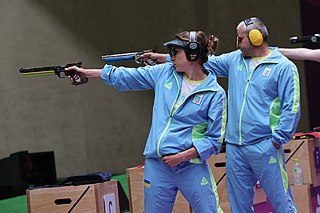
The 10 meter air pistol is an Olympic shooting event governed by the International Shooting Sport Federation (ISSF). It is similar to 10 meter air rifle in that it is shot with 4.5 mm caliber air guns at a distance of 10 metres (11 yards), and that the match consists of a qualification round of 60 competition shots within 75 minutes. If an Electronic Scoring System (EST) is not available, 15 minutes are added to the time limit. Competitors are allowed to shoot an unlimited number of shots during the 15 minutes preparation and sighting time. Along with the 50 meter pistol, it is considered a precision shooting event. Thus, numerous shooters compete in both events.

Emmetropia is the state of vision in which a faraway object at infinity is in sharp focus with the ciliary muscle in a relaxed state. That condition of the normal eye is achieved when the refractive power of the cornea and eye lens and the axial length of the eye balance out, which focuses rays exactly on the retina, resulting in perfectly sharp distance vision. A human eye in a state of emmetropia requires no corrective lenses for distance; the vision scores well on a visual acuity test.
Adjustable focus eyeglasses are eyeglasses with an adjustable focal length. They compensate for refractive errors by providing variable focusing, allowing users to adjust them for desired distance or prescription, or both.
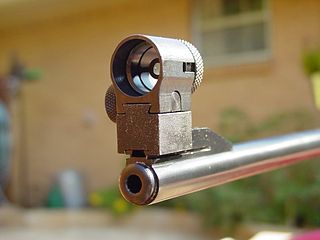
A globe sight is a front sight component used to assist the aiming of a gun/device, usually those intended to launch projectiles, such as firearms, airguns, and crossbows. It is found in particular as a front sight element on rifles.
A circle contact lens, also known as a big eye contact lens and circle lens, is a cosmetic contact lens that makes the eye's iris appear larger. It has become a trend throughout East, South and Southeast Asia and is largely produced in Japan, South Korea and China.

A pinhole occluder is an opaque disk with one or more small holes through it, used by ophthalmologists, orthoptists and optometrists to test visual acuity. The occluder is a simple way to focus light, as in a pinhole camera, temporarily removing the effects of refractive errors such as myopia. Because light passes only through the center of the eye's lens, defects in the shape of the lens have no effect while the occluder is used. In this way, the ophthalmologist, orthoptist or optometrist can estimate the maximum improvement in a patient's vision that can be attained by lenses to correct errors of refraction. This can be used to distinguish visual defects caused by refractive error, which improve when the occluder is used, from other problems, which do not. The pinhole occluder can also be used in testing visual acuity in mydriatic patients. In this case, the pinhole occluder compensates for the inability to contract the iris assisting the eye in obtaining a retinal projection similar to that of a non-cycloplegic eye.

A diopter sight is an aperture sight component used to assist the aiming of ranged weapons, mainly firearms, airguns, and crossbows. Diopters function to precisely align the shooter's eye with the front sight and the target, while also producing beneficial optical effects for accurate aiming. A diopter must be paired with a complementing front sight element to obtain a usable sighting line. Diopter sights used for modern target shooting allow for very fine windage and elevation adjustments, moving the impact point on the order of less than five millimeters at a range of 100 metres. High end diopters typically accept accessories to aid the shooter's ability to see the target clearly.
Vision of humans and other organisms depends on several organs such as the lens of the eye, and any vision correcting devices, which use optics to focus the image.

A red dot sight is a common classification for a non-magnifying reflector sight that provides an illuminated red dot to the user as a point of aim. A standard design uses a red light-emitting diode (LED) at the focus of collimating optics, which generates a dot-style illuminated reticle that stays in alignment with the firearm the sight is attached to, regardless of eye position.
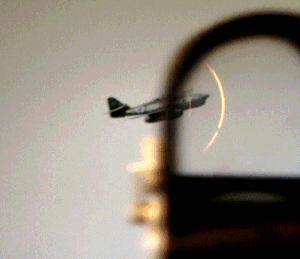
A reflector sight or reflex sight is an optical sight that allows the user to look through a partially reflecting glass element and see an illuminated projection of an aiming point or some other image superimposed on the field of view. These sights work on the simple optical principle that anything at the focus of a lens or curved mirror will appear to be sitting in front of the viewer at infinity. Reflector sights employ some form of "reflector" to allow the viewer to see the infinity image and the field of view at the same time, either by bouncing the image created by lens off a slanted glass plate, or by using a mostly clear curved glass reflector that images the reticle while the viewer looks through the reflector. Since the reticle is at infinity it stays in alignment with the device to which the sight is attached regardless of the viewer's eye position, removing most of the parallax and other sighting errors found in simple sighting devices.

A holographic weapon sight or holographic diffraction sight is a non-magnifying gunsight that allows the user to look through a glass optical window and see a holographic reticle image superimposed at a distance on the field of view. The hologram of the reticle is built into the window and is illuminated by a laser diode.

A pinhole is a small circular hole, as could be made with the point of a pin. In optics, pinholes with diameter between a few micrometers and a hundred micrometers are used as apertures in optical systems. Pinholes are commonly used to spatially filter a beam, where the small pinhole acts as a low-pass filter for spatial frequencies in the image plane of the beam.

Subjective Refraction is a technique to determine the combination of lenses that will provide the best corrected visual acuity (BCVA). It is a clinical examination used by orthoptists, optometrists and ophthalmologists to determine a patient's need for refractive correction, in the form of glasses or contact lenses. The aim is to improve current unaided vision or vision with current glasses. Glasses must also be comfortable visually. The sharpest final refraction is not always the final script the patient wears comfortably.

A prism sight or prismatic sight, sometimes also called prism scope or prismatic scope, is a type of telescopic sight which uses a reflective prism for its image-erecting system, instead of the series of relay lenses found in traditional telescopic sights. The use of prisms makes it possible to construct a shorter and lighter sight, or with an offset between the eyepiece and objective axes, although restricting the achievable range of magnification.








